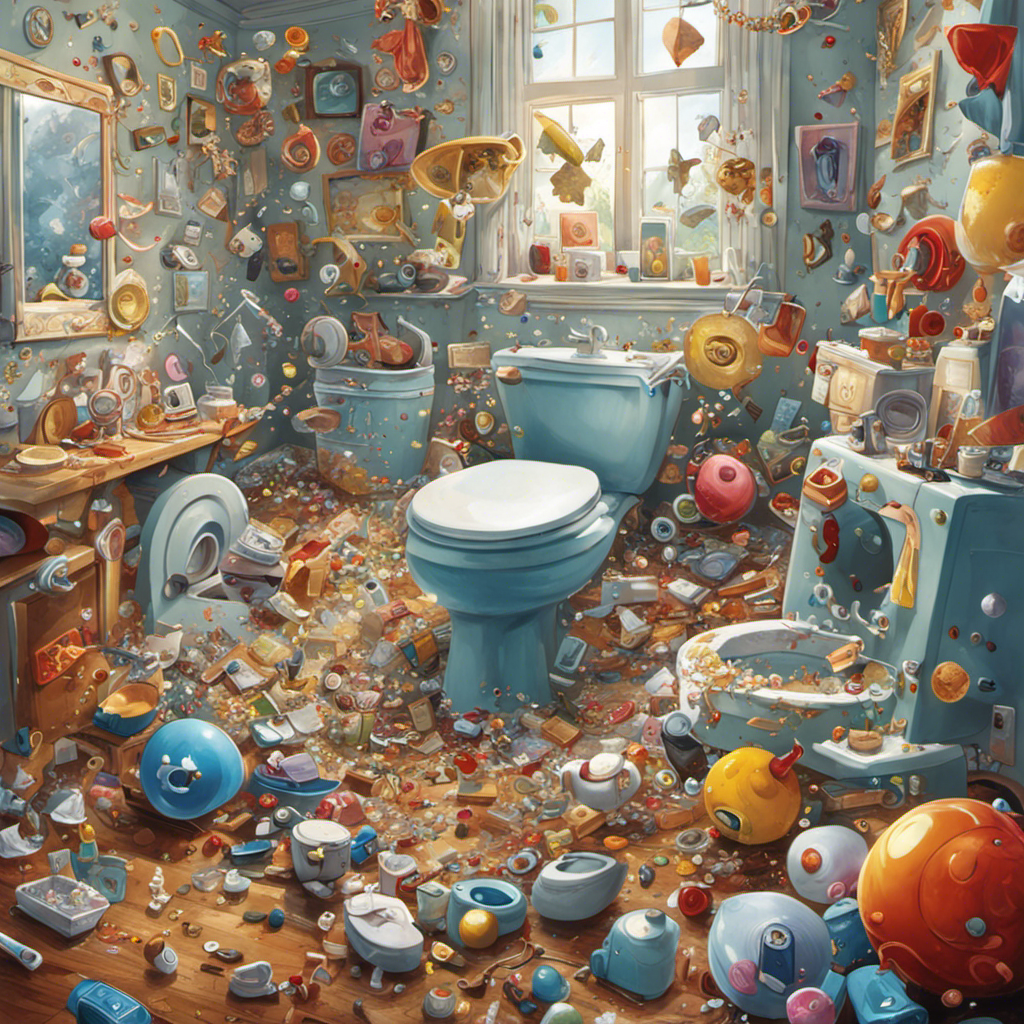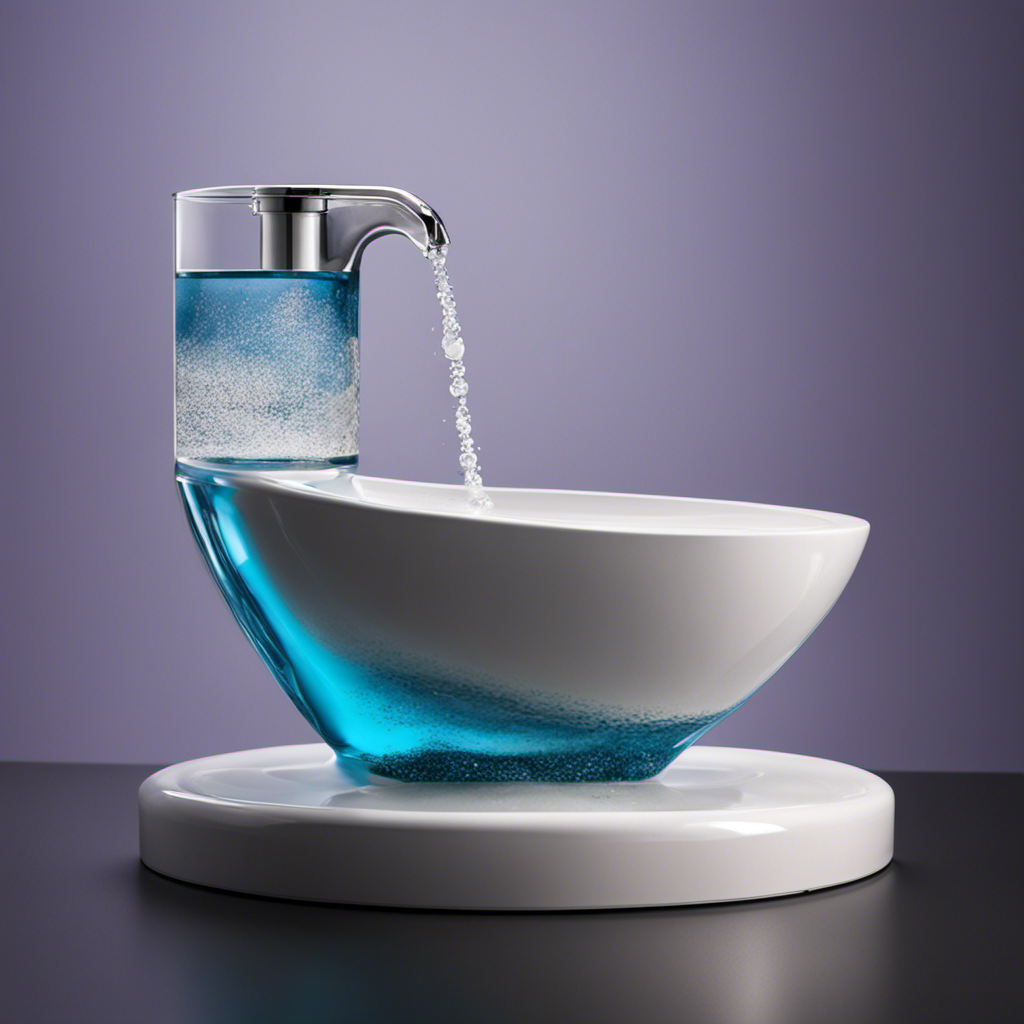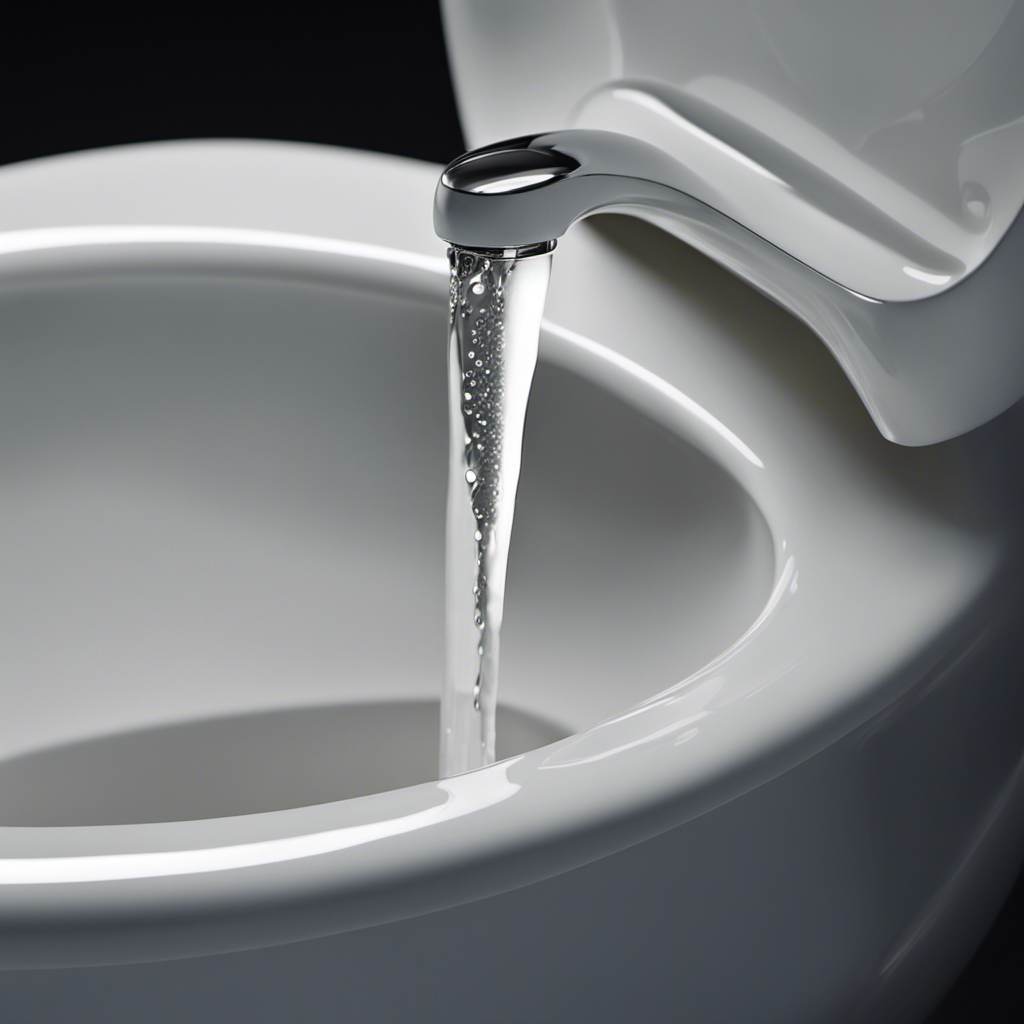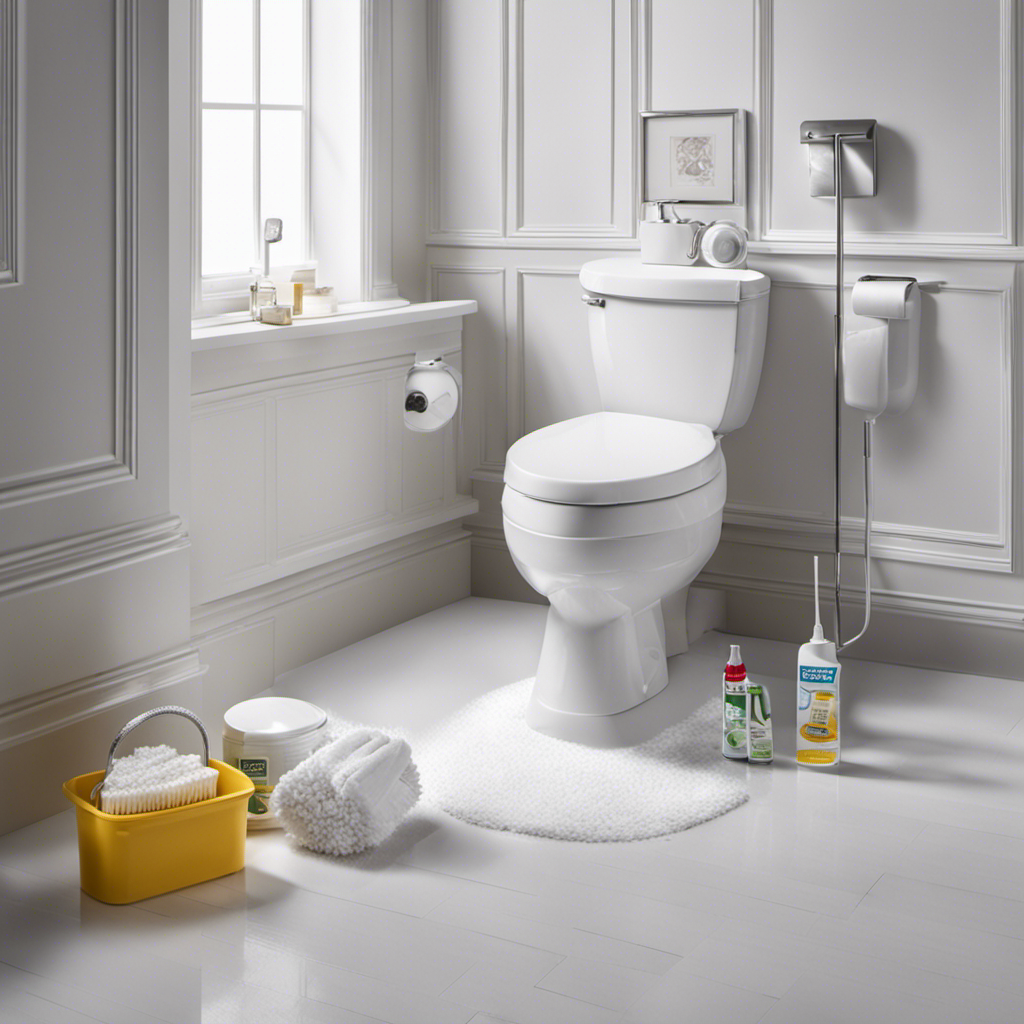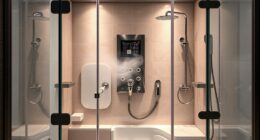Have you ever experienced that sinking feeling when something slips from your grasp and disappears down the toilet? It’s a moment of panic, wondering what happens next.
In this article, I’ll guide you through the consequences of accidentally flushing items and the potential damages it can cause to your plumbing system.
From common objects that find their way into the toilet bowl to the steps you should take immediately after flushing, we’ll explore it all.
So, join me as we dive into the world of accidental toilet flushes and discover how to avoid them.
Key Takeaways
- Accidentally flushing non-flushable items like keys, toys, and dental floss can cause significant problems in the plumbing system, leading to clogs and blockages.
- Flushing non-flushable items can result in damage to pipes, clogged toilets, expensive repairs, potential burst pipes, and the need for emergency plumber services.
- Preventive measures such as having a nearby trash can, disposing of non-flushable items properly, being cautious with excessive toilet paper usage, and regularly inspecting toilet components can help avoid accidental flushing.
- Flushing non-biodegradable items has a negative environmental impact, as they don’t break down easily, can clog pipes and sewer systems, pose a threat to marine life by causing ingestion and health issues, and disrupt aquatic ecosystems.
Common Objects That Get Accidentally Flushed
Some common objects that people accidentally flush down the toilet include keys, toys, and dental floss. It may seem harmless at first, but these items can cause significant problems in your plumbing system.
When flushed, these objects can get lodged in the pipes, leading to clogs and blockages. This can result in toilets that won’t flush properly or overflowing toilets. To avoid such issues, it is important to be mindful of what you flush down the toilet.
Additionally, using toilet paper alternatives, such as wet wipes, can also contribute to clogs. If you do find yourself facing a clogged toilet, there are DIY unclogging methods you can try before calling a plumber.
These include using a plunger, a plumbing snake, or a mixture of baking soda and vinegar to break up the clog.
How Flushing Affects Your Plumbing System
When it comes to flushing, there are several potential issues that can arise within your plumbing system. One of the most common problems is clogs and blockages, which can occur when non-flushable items like wipes or paper towels are flushed down the toilet.
These blockages can lead to pipe damage risks, including cracks or leaks, which can be expensive to repair. It is important to be aware of these potential risks and take preventative measures to avoid costly repairs in the future.
Clogs and Blockages
If you accidentally flush something down the toilet, you might experience a clog or blockage. It’s important to understand clog prevention and proper toilet maintenance to avoid these issues. Here are some key points to remember:
-
Regular cleaning: Keeping your toilet clean and free from buildup will help prevent clogs. Use a toilet brush and cleaner to remove any residue or debris.
-
Avoid flushing non-flushable items: Only flush toilet paper and human waste. Flushing items like baby wipes, cotton balls, or feminine hygiene products can lead to clogs.
-
Use a plunger: If you do encounter a clog, a plunger can often resolve the problem. Make sure to use a plunger specifically designed for toilets and follow the proper plunging technique.
-
Seek professional help: If a clog persists or you suspect a more serious blockage, it’s best to call a professional plumber. They have the necessary tools and expertise to resolve the issue safely and efficiently.
Pipe Damage Risks
Pipe damage can lead to costly repairs and potential water damage in your home. Proper pipe maintenance is essential to prevent these issues and ensure the longevity of your plumbing system.
Regular inspections and timely repairs can help identify and address any potential problems before they escalate. Additionally, having access to emergency plumbing services is crucial in case of unexpected pipe damage or leaks.
These services provide immediate assistance and can help mitigate the damage caused by pipe issues. By investing in regular pipe maintenance and having emergency plumbing services readily available, you can minimize the risk of costly repairs and protect your home from potential water damage.
Potential Costly Repairs
To avoid potential costly repairs, it’s important to address any pipe damage as soon as possible. Ignoring the issue can lead to more extensive damage and higher repair costs. Here are some cost-saving tips and DIY fixes to help you avoid unnecessary expenses:
- Regularly inspect your pipes for signs of damage, such as leaks or corrosion.
- Use drain screens or traps to prevent debris from entering the pipes and causing blockages.
- If you notice a small leak, try using pipe sealant or epoxy putty to temporarily fix the issue until a professional can assess the damage.
- Use a plunger or drain snake to clear minor clogs before they become major blockages.
- Avoid using harsh chemicals to unclog drains, as they can damage the pipes over time.
- Educate yourself on basic plumbing repairs and maintenance to tackle minor issues on your own.
Risks and Potential Damages Caused by Flushed Items
When it comes to the risks and potential damages caused by flushed items, there are several key points to consider.
First, plumbing blockages and backups can occur when non-flushable items get stuck in the pipes, leading to clogs and reduced water flow.
Additionally, there is the risk of environmental pollution as these items can end up in our waterways, harming aquatic life and ecosystems.
Lastly, the consequences of these issues can result in costly repairs and replacements, as damaged pipes may need to be fixed or replaced entirely to restore proper functioning.
Plumbing Blockages and Backups
If you’re not careful, you could end up causing a plumbing backup by flushing the wrong items down the toilet. Common causes of plumbing blockages and backups include:
- Flushing non-flushable items: Items like wipes, sanitary products, and dental floss should never be flushed down the toilet as they can easily clog the pipes.
- Excessive toilet paper usage: Using an excessive amount of toilet paper in one flush can overwhelm the pipes and lead to blockages.
- Tree root intrusion: Tree roots can grow into the sewer lines, causing blockages and backups.
To prevent plumbing blockages and backups, consider the following tips:
- Only flush toilet paper and human waste down the toilet.
- Dispose of non-flushable items in the trash.
- Regularly maintain your plumbing system to detect and address any potential issues.
By following these prevention tips, you can avoid the hassle and potential damage of a plumbing backup.
However, flushing the wrong items down the toilet doesn’t just pose risks for your plumbing system; it can also contribute to environmental pollution risks.
Environmental Pollution Risks
Flushing non-flushable items can contribute to environmental pollution risks, so it’s important to dispose of them properly. When these items are flushed down the toilet, they can end up in our waterways, posing serious risks for marine life and impacting water quality. The chemicals and pollutants from these items can contaminate the water, harming aquatic organisms and disrupting the delicate balance of ecosystems. To illustrate the potential impact of flushing non-flushable items, consider the table below:
| Non-flushable Item | Environmental Impact |
|---|---|
| Wet wipes | Clogs pipes and pollutes water |
| Dental floss | Entangles wildlife |
| Cotton swabs | Accumulates in the environment |
| Medications | Contaminates water |
As you can see, the consequences of improper disposal can be far-reaching and damaging. In the next section, we will explore the costly repairs and replacements that can result from flushing these items.
Costly Repairs and Replacements
Improper disposal of non-flushable items can lead to costly repairs and replacements. Flushing items that are not designed to be flushed can cause serious damage to your plumbing system. Here are some consequences and prevention measures to consider:
-
Damage to pipes: Non-flushable items like wipes, dental floss, and feminine hygiene products can clog pipes, leading to blockages and potential burst pipes.
-
Malfunctioning toilets: Items that don’t break down easily, such as toys or cotton balls, can cause toilets to clog and overflow, requiring the assistance of an emergency plumber.
-
Expensive repairs: Fixing a damaged plumbing system can be costly, especially if the problem has gone unnoticed for an extended period.
To avoid these issues, it’s crucial to only flush toilet paper and waste. Remember, prevention is key to avoid the need for expensive repairs or the assistance of an emergency plumber.
Now, let’s explore the steps to take immediately after flushing something down the toilet.
Steps to Take Immediately After Flushing Something
After accidentally flushing something down the toilet, you should quickly turn off the water supply to prevent any further damage. This is crucial because the continuous flow of water can exacerbate the situation and cause potential health hazards.
When an item gets flushed, it can clog the pipes and interrupt the normal flow of wastewater. This can lead to backups, leaks, and even flooding. Furthermore, certain items may contain harmful substances that can contaminate the water supply if not properly disposed of.
To avoid these issues, it is important to follow proper disposal methods. This includes never flushing non-biodegradable items, such as plastics or chemicals. Instead, these items should be disposed of in the appropriate designated waste containers to ensure the safety of both the plumbing system and the environment.
Professional Solutions for Retrieving Flushed Items
If you’ve accidentally flushed an item down the toilet, professionals can provide effective solutions for retrieving it. Here are some options for retrieving flushed items:
-
Use retrieval tools:
-
Toilet auger: This tool has a long, flexible cable that can be inserted into the toilet drain to grab and retrieve the item.
-
Drain snake: Similar to a toilet auger, a drain snake can be used to navigate the drain and hook onto the item for removal.
-
DIY techniques:
-
Wet/dry vacuum: By creating a seal around the drain, a wet/dry vacuum can suck out the water and potentially retrieve the item.
-
Plunger: A plunger can create suction and pressure to dislodge the item and bring it back up through the drain.
-
Call a professional: If all else fails, it’s best to call a professional plumber who has the experience and specialized tools to retrieve flushed items without causing further damage.
Preventive Measures to Avoid Accidental Flushing
To prevent accidental flushing, remember to always be mindful of what you put near the toilet. Proper toilet maintenance and disposal practices are crucial in avoiding clogs and potential damage to your plumbing system.
Firstly, ensure that you have a trash can nearby to dispose of non-flushable items such as wipes, tampons, and dental floss. These items can easily clog your toilet, leading to costly repairs.
Additionally, be cautious when using excessive amounts of toilet paper, as too much can also cause blockages.
Regularly inspect the toilet flush valve and flapper for any signs of wear or damage, as these components play a vital role in the proper functioning of your toilet.
Environmental Impact of Flushing Non-Biodegradable Items
Remember, flushing non-biodegradable items down the toilet can have a significant environmental impact. It is crucial to be aware of the consequences of such actions. Here are some key points to consider:
-
Non-biodegradable items, like plastic and synthetic materials, do not break down easily in water systems.
-
They can clog pipes and sewer systems, leading to costly repairs and maintenance.
-
These items can also end up in water bodies, posing a serious threat to marine life.
-
Marine animals may mistake them for food, resulting in ingestion and subsequent health issues or death.
-
The presence of non-biodegradable waste can disrupt the delicate balance of aquatic ecosystems.
To minimize the impact on the environment and marine life, it is important to explore alternative disposal methods for non-biodegradable items. Recycling, proper waste segregation, and using designated collection points for hazardous materials can all contribute to a cleaner and safer environment.
Frequently Asked Questions
Can Flushing Non-Biodegradable Items Down the Toilet Cause Harm to the Environment?
Flushing non-biodegradable items down the toilet can harm the environment. Plastic waste can impact marine life. Sewage treatment plants play a crucial role in reducing environmental damage caused by flushing these items.
What Are Some Preventive Measures to Avoid Accidentally Flushing Items?
To avoid accidentally flushing items, it’s crucial to take precautionary measures. Proper disposal is key. By being mindful of what we flush, we can prevent potential plumbing issues and protect our environment.
Are There Any Professional Solutions Available for Retrieving Flushed Items?
Professional retrieval services can be hired to retrieve items accidentally flushed down the toilet. They have specialized tools and expertise to safely retrieve objects. DIY methods, like using a plunger or drain snake, can also be attempted but may not always be successful.
What Are the Immediate Steps to Take After Accidentally Flushing Something Down the Toilet?
After accidentally flushing something down the toilet, the immediate actions to take include turning off the water supply, avoiding flushing again, and contacting a plumber. Consequences may include clogs, pipe damage, and water leaks.
Are There Any Risks or Potential Damages Caused by Flushing Items Down the Toilet?
Well, let me tell you, flushing random stuff down the toilet can lead to some serious risks and damages. It’s like playing a dangerous game of plumbing roulette. Don’t do it!
Conclusion
In conclusion, flushing something down the toilet can have serious consequences for your plumbing system. It can cause clogs, blockages, and even damage to your pipes. It is important to take immediate action by turning off the water supply and contacting a professional plumber for assistance.
Additionally, prevention is key in avoiding accidental flushing. Always be mindful of what you are flushing and never dispose of non-biodegradable items in the toilet. Remember, a small mistake can lead to big problems.
